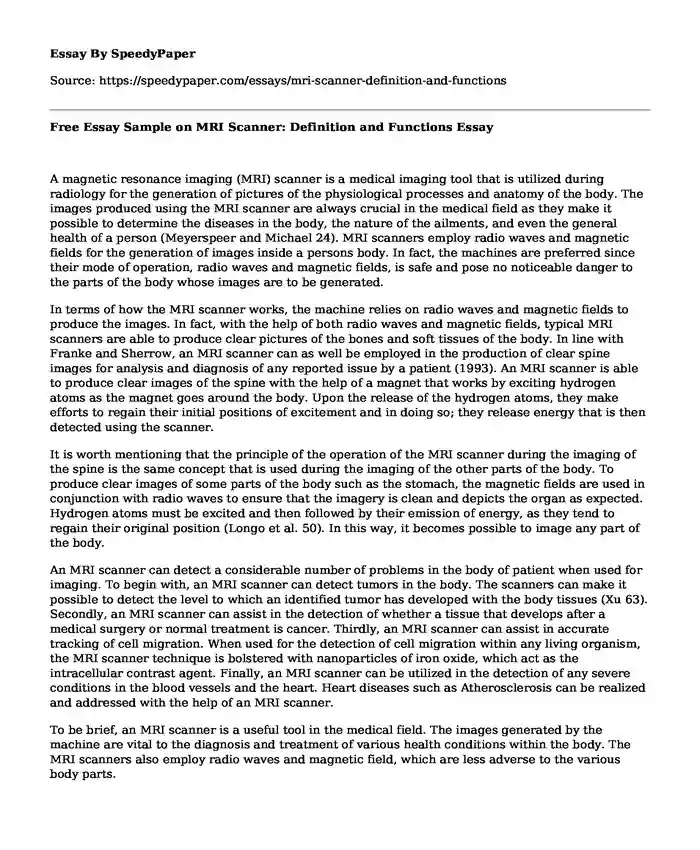
| Type of paper: | Essay |
| Categories: | Medicine Technology |
| Pages: | 3 |
| Wordcount: | 685 words |
A magnetic resonance imaging (MRI) scanner is a medical imaging tool that is utilized during radiology for the generation of pictures of the physiological processes and anatomy of the body. The images produced using the MRI scanner are always crucial in the medical field as they make it possible to determine the diseases in the body, the nature of the ailments, and even the general health of a person (Meyerspeer and Michael 24). MRI scanners employ radio waves and magnetic fields for the generation of images inside a persons body. In fact, the machines are preferred since their mode of operation, radio waves and magnetic fields, is safe and pose no noticeable danger to the parts of the body whose images are to be generated.
In terms of how the MRI scanner works, the machine relies on radio waves and magnetic fields to produce the images. In fact, with the help of both radio waves and magnetic fields, typical MRI scanners are able to produce clear pictures of the bones and soft tissues of the body. In line with Franke and Sherrow, an MRI scanner can as well be employed in the production of clear spine images for analysis and diagnosis of any reported issue by a patient (1993). An MRI scanner is able to produce clear images of the spine with the help of a magnet that works by exciting hydrogen atoms as the magnet goes around the body. Upon the release of the hydrogen atoms, they make efforts to regain their initial positions of excitement and in doing so; they release energy that is then detected using the scanner.
It is worth mentioning that the principle of the operation of the MRI scanner during the imaging of the spine is the same concept that is used during the imaging of the other parts of the body. To produce clear images of some parts of the body such as the stomach, the magnetic fields are used in conjunction with radio waves to ensure that the imagery is clean and depicts the organ as expected. Hydrogen atoms must be excited and then followed by their emission of energy, as they tend to regain their original position (Longo et al. 50). In this way, it becomes possible to image any part of the body.
An MRI scanner can detect a considerable number of problems in the body of patient when used for imaging. To begin with, an MRI scanner can detect tumors in the body. The scanners can make it possible to detect the level to which an identified tumor has developed with the body tissues (Xu 63). Secondly, an MRI scanner can assist in the detection of whether a tissue that develops after a medical surgery or normal treatment is cancer. Thirdly, an MRI scanner can assist in accurate tracking of cell migration. When used for the detection of cell migration within any living organism, the MRI scanner technique is bolstered with nanoparticles of iron oxide, which act as the intracellular contrast agent. Finally, an MRI scanner can be utilized in the detection of any severe conditions in the blood vessels and the heart. Heart diseases such as Atherosclerosis can be realized and addressed with the help of an MRI scanner.
To be brief, an MRI scanner is a useful tool in the medical field. The images generated by the machine are vital to the diagnosis and treatment of various health conditions within the body. The MRI scanners also employ radio waves and magnetic field, which are less adverse to the various body parts.
Works Cited
Franke, Jochen, and Pinder Sherrow. "System Characterization of a Highly Integrated Preclinical Hybrid MPI-MRI Scanner." IEEE Transactions on Medical Imaging 9 (2016): 1993-1996. Print.
Longo, Dario et al. "Gd-AAZTA-MADEC, an Improved Blood Pool Agent for DCE-MRI Studies On Mice on 1 T Scanners." Biomaterials 75. (2016): 47-57. Print.
Meyerspeer, Martin, and Sandel Michael. "Simultaneous and Interleaved Acquisition of NMR Signals from Different Nuclei with a Clinical MRI Scanner." Magnetic Resonance in Medicine 5 (2016): 23-26. Print.
Xu, Ye, et al. "Superparamagnetic MRI Probes For In Vivo Tracking of Dendritic Cell Migration with a Clinical 3 T Scanner." Biomaterials 58. (2015): 63-71. Print.
Cite this page
Free Essay Sample on MRI Scanner: Definition and Functions. (2019, Dec 13). Retrieved from https://speedypaper.net/essays/mri-scanner-definition-and-functions
Request Removal
If you are the original author of this essay and no longer wish to have it published on the SpeedyPaper website, please click below to request its removal:
- Technology Essay Sample: Video Streaming Protocol
- Essay Sample on Neurocognitive Disorder (NCDs)
- Essay Sample: Marriage Analysis in Romeo and Juliet and Much Ado about Nothing
- Engineering and Sustainability
- Essay Example on Global Marketing: An Analysis of France as a Potential New Market for Lyft
- Essay Sample on Tragedy and Art
- Free Essay. Differential diagnosis of disorders
Popular categories




